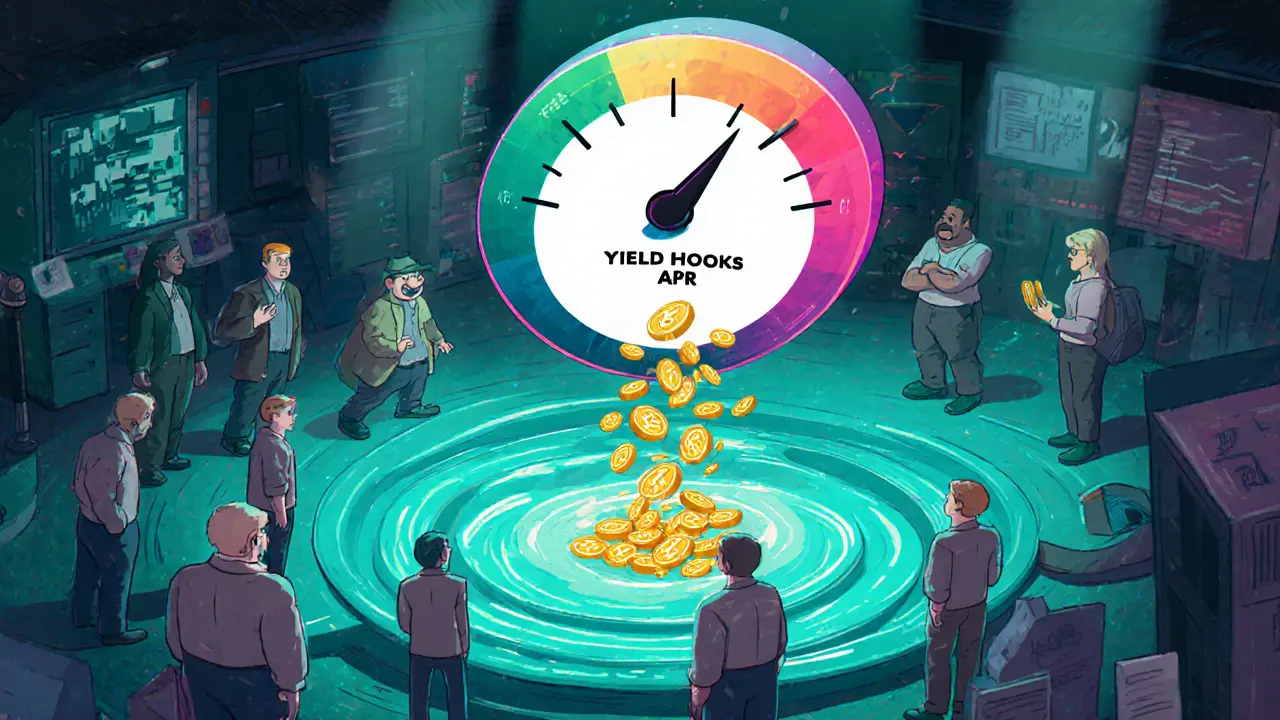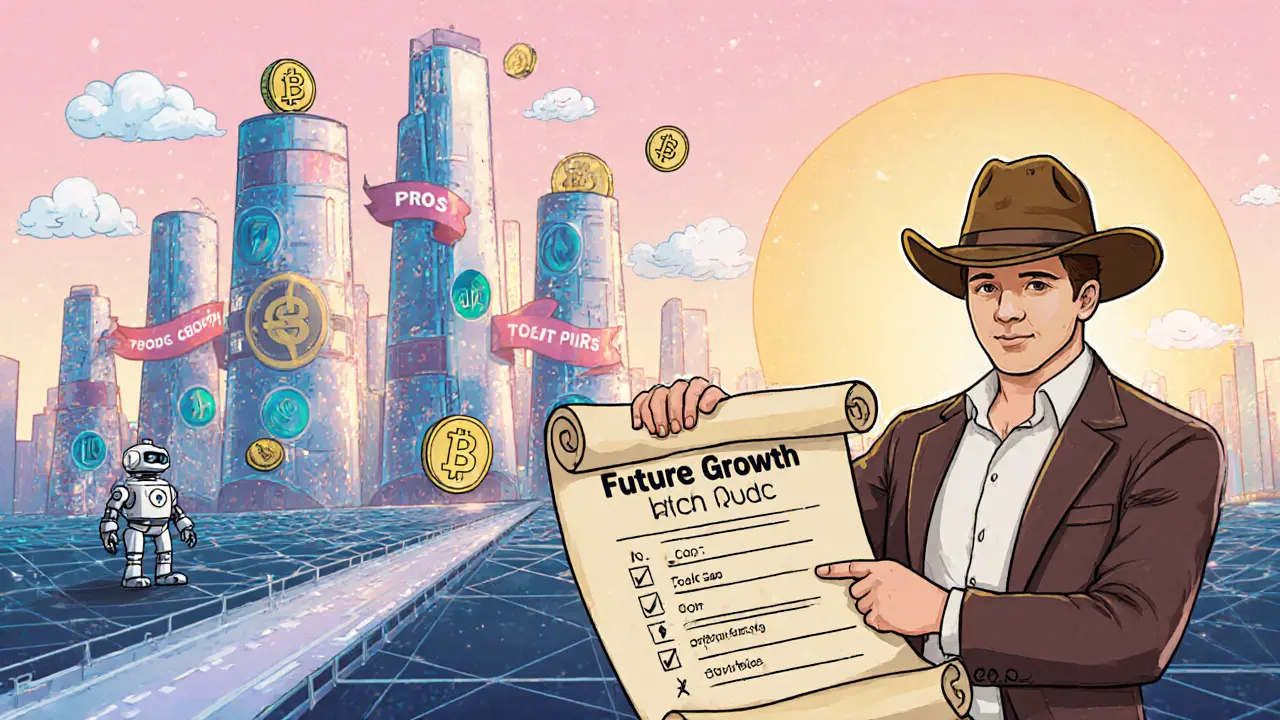Uniswap V3 (Blast) Liquidity Calculator
Potential Liquidity Pool Earnings
With 0 USDC provided in a medium range around $3000 ETH/USDC:
- Swap Fee Income: $0.00 per week
- Yield Hook Bonus: $0.00 per week
- Total Weekly Earnings: $0.00
- Estimated Annualized Return: 0.00%
Note: Results are estimates based on current data and may vary depending on actual market conditions.
Key Takeaways
- Uniswap V3 (Blast) runs on the Blast Layer2, offering tighter spreads (≈0.68%) and native yield hooks.
- Only 2 tokens and 4 pairs are live, so liquidity is modest but growing.
- Fees stay close to the classic 0.30% maker/taker model, with no extra margin‑trading costs.
- Non‑custodial design keeps full control of assets, but gas on Ethereum still impacts cost.
- Future growth hinges on Blast adoption and competition from Uniswap V4 and other L2 DEXs.
Uniswap V3 (Blast) is a decentralized cryptocurrency exchange that launched in 2024 on the Blast Layer2 network. It inherits Uniswap V3’s concentrated‑liquidity model while tapping Blast’s native yield‑generation hooks, aiming to give users better capital efficiency than the Ethereum mainnet version.
What Sets the Blast Deployment Apart?
At its core, the Blast version keeps the same automated market maker (AMM) engine that made Uniswap a DeFi staple. The big difference is the underlying L2 stack: Blast reduces transaction latency and gas fees, which translates into the 0.68% average bid‑ask spread observed in October2025. This spread is tighter than many newer DEXs on Ethereum but still wider than the sub‑0.3% spreads on some highly optimized L2s like Optimism.
Another unique piece is the “yield hooks” feature. Blast Layer 2 network offers native incentive contracts that liquidity providers (LPs) can plug into, potentially boosting APR beyond the baseline swap fees earned in the pool.
Technical Specs & Current Market Position
The platform currently supports two coins (USDC and ETH) across four trading pairs. Though the token list is short, the concentrated‑liquidity design lets LPs allocate capital to very narrow price bands, extracting more fee revenue per dollar locked.
- Average spread: 0.68%
- Volume percentile: 58th among DEXes
- Order‑book percentile: 15th (combined orderbook metric)
- Fees: typically 0.30% maker+taker (no extra market‑maker fees)
- No margin trading, no custodial holdings
In the broader Uniswap ecosystem, daily volume sits between $1‑2billion across all chains, with Uniswap V4 already processing over $100billion in cumulative volume. By comparison, the Blast deployment is an early‑stage player, but its L2 efficiency gives it a niche edge for yield‑hungry traders.
How to Get Started - Wallets and Funding
Accessing Uniswap V3 (Blast) is straightforward if you already have an EVM‑compatible wallet. MetaMask is the most common choice; it auto‑detects the Blast network once you add the RPC endpoint. After connecting, you’ll see the swap interface with the limited pair list.
Funding can come from any external wallet or exchange. For fiat‑on‑ramp users, third‑party services like MoonPay are available. MoonPay charges 2.55‑3.65% for card purchases and 0.99% for bank transfers, but keep in mind that MoonPay requires KYC, whereas the Uniswap contract itself does not.

Yield Opportunities and Fee Structure
Liquidity providers on Blast can earn two streams: the standard 0.30% swap fee and any additional rewards from Blast’s native hooks. Early LPs have reported APRs in the 12‑18% range when combining fees with hook incentives, which is notably higher than the ~5‑8% typical on Ethereum‑only pools.
Because the platform is non‑custodial, you retain full ownership of your LP tokens and can withdraw at any time. However, you still face gas costs for adding/removing liquidity, though these are dramatically lower on Blast than on mainnet.
How It Stacks Up Against Alternatives
| Feature | Uniswap V3 (Blast) | Uniswap V4 (Ethereum) | PancakeSwap (BSC) | Curve (Optimism) |
|---|---|---|---|---|
| Supported chains | Blast L2 (EVM) | Ethereum Mainnet | Binance Smart Chain | Optimism L2 |
| Token pairs (live) | 2 tokens, 4 pairs | ~200 tokens, 500+ pairs | ~150 tokens, 300+ pairs | ~80 tokens, 200+ pairs |
| Average spread | 0.68% | ≈0.30‑0.45% | ≈0.50% | ≈0.35% |
| Base fee | 0.30% (maker+taker) | 0.30% (standard) | 0.20% (swap) | 0.04% (stable‑swap) |
| Yield hooks / incentives | Native Blast hooks (∼12‑18% APR) | None (fee‑only) | CAKE token farms | CRV emissions |
| KYC requirement | None (contract only) | None | None | None |
The table shows that Uniswap V3 (Blast) shines on fee simplicity and L2 yield hooks, while it lags behind in token variety and sheer volume compared with V4 or PancakeSwap. For users focused on high‑efficiency LP strategies, Blast offers a compelling niche.
Pros, Cons, and Who Should Use It
- Pros
- Low gas fees thanks to Blast L2.
- Concentrated liquidity + native yield hooks boost earnings.
- Non‑custodial, no KYC for pure swaps.
- Cons
- Limited token selection (only 2 coins, 4 pairs).
- Liquidity depth is still developing; larger trades may slip.
- Reliance on Blast’s long‑term viability and security.
The exchange is best for experienced DeFi users who want to allocate capital efficiently and are comfortable managing LP risk. Beginners can still swap small amounts, but they may find the narrow token list restrictive.
Future Outlook
Uniswap’s roadmap points to deeper integration with Layer2 solutions. As Blast gains traction-expected to double its TVL by mid‑2026-Uniswap V3 (Blast) could expand its token roster and introduce cross‑pool routing to compete directly with V4’s multi‑chain aggregator.
Regulatory pressure remains a wildcard. Because the protocol operates without custodial intermediaries, typical securities rules don’t apply, but governments may still target on‑ramps like MoonPay. Users should stay vigilant about KYC changes on third‑party services.
Key Takeaways for Action
- Set up a MetaMask wallet and add the Blast RPC endpoint.
- Fund with ETH or USDC; consider a small test swap first.
- If you’re an LP, allocate capital to tight price ranges and enable Blast’s yield hook to capture the extra APR.
- Monitor gas on both Blast and Ethereum-switch back to mainnet only when necessary.
- Keep an eye on Uniswap announcements; new token pairs often roll out with community voting.

Frequently Asked Questions
Is Uniswap V3 (Blast) safe to use?
The smart contracts are audited and inherit Uniswap V3’s proven AMM logic. Safety largely depends on the Blast network’s security, which has passed multiple audits as of 2025. As with any DeFi protocol, you should only allocate funds you’re comfortable risking.
What wallets work with the Blast deployment?
Any EVM‑compatible wallet that lets you add custom RPCs works. MetaMask, Trust Wallet, and Coinbase Wallet are the most popular choices. After adding Blast’s RPC URL, the Uniswap interface will appear automatically.
Can I trade on Uniswap V3 (Blast) without KYC?
Yes. Direct swaps on the contract require no identity verification. However, if you buy crypto through an on‑ramp like MoonPay, you’ll need to complete their KYC flow.
How do Blast’s yield hooks work?
Yield hooks are smart contracts that distribute extra token rewards to LPs based on the amount of liquidity they provide within a chosen price range. The hook’s reward token can be native Blast tokens or other incentive tokens, adding a separate revenue stream on top of swap fees.
Will Uniswap V3 (Blast) add more token pairs?
The community can propose new pools via Uniswap’s governance portal. Historically, popular pairs are added within weeks of a vote passing, so expect the list to grow as Blast gains users.


victor white
April 18, 2025 AT 18:00One must first acknowledge that Uniswap V3, now cloaked in the Blast moniker, is not merely a protocol upgrade but an artistic rendition of capital allocation. The intricacies of concentrated liquidity, when examined through a baroque lens, reveal a tapestry woven with both elegance and peril. By narrowing price ranges to a mercurial ±1%, one courts the siren of amplified fees while courting the abyss of impermanent loss. The fee tiers, now more granular, can be likened to a palette of pigments-each hue lending its own shimmer to the liquidity canvas. Yet, the very notion of “yield” in this context is a chimera, a phantom that flits between on‑chain metrics and off‑chain market sentiment. The calculator embedded within the article, though polished, abstracts away the stochastic nature of gas costs, which can erode any marginal gains. Moreover, the Blast infrastructure introduces a latency layer that, while ostensibly benign, may subtly shift the timing of arbitrage opportunities. For the discerning capital allocator, the decision matrix expands beyond simple APR calculations to encompass risk‑adjusted return vectors. Consider, for instance, the interplay between swap fee APR and the emergent yield hooks that reward active participants with protocol‑specific incentives. The latter, though enticing, carry vesting schedules that resemble a slow‑burning ember rather than an immediate flame. In practice, a liquidity provider must calibrate not only the token ratio but also the temporal exposure, lest they become a passive victim of market volatility. The broader DeFi ecosystem, too, exerts external pressures: regulatory murmurs, tokenomics revisions, and cross‑protocol migrations all conspire to reshape the profitability landscape. It is therefore incumbent upon the participant to wield both quantitative rigor and qualitative intuition. In the final analysis, Uniswap V3 (Blast) is a double‑edged sword; it gleams with the promise of heightened returns yet severs the naïve from the sagacious. Hence, one should approach with the measured patience of a seasoned alchemist, distilling raw data into actionable insight.
mark gray
April 24, 2025 AT 12:53Liquidity is king.
Anthony R
April 30, 2025 AT 07:47I’m impressed-this calculator is slick; however, users should double‑check inputs, especially when estimating fee APR, because small errors can balloon over time, right?; moreover, the UI feels crisp, yet the underlying assumptions remain hidden, so tread carefully.
Vaishnavi Singh
May 6, 2025 AT 02:40When one ponders the nature of yield on Uniswap V3, the mind drifts to the balance between risk and reward; the narrow price bands echo the ancient philosophical notion of walking a tightrope, where every step must be deliberate, lest the oscillations of the market drag you into oblivion.
Kevin Fellows
May 11, 2025 AT 21:33Hey folks, looks like a cool tool – might help us snag some extra fees without too much hassle. Let’s give it a spin!
meredith farmer
May 17, 2025 AT 16:27Seriously, this whole “Blast” rebrand is a smokescreen. They’re pushing us into tighter ranges while the hidden fee structure gets more opaque. Don’t be fooled – the system’s designed to siphon off the little guys.
Cindy Hernandez
May 23, 2025 AT 11:20Uniswap V3’s concentrated liquidity can be a powerful tool when used correctly. By selecting a price range that matches your market view, you can maximize fee capture. Just remember to monitor the range and adjust as market conditions evolve.
Karl Livingston
May 29, 2025 AT 06:13The calculator is neat, but you’ve got to stay aware of gas fees – they can eat into those sweet fee earnings. If you’re comfortable with a bit of volatility, the medium range could be a sweet spot.
Kyle Hidding
June 4, 2025 AT 01:07Let’s cut the fluff: this UI is just a veneer. Underneath, the fee math is riddled with assumptions that benefit the protocol, not the LP. It’s a classic case of veneer over vapor.
Andrea Tan
June 9, 2025 AT 20:00Looks like a solid starting point for newbies – just remember it’s an estimate, not a guarantee.
Cody Harrington
June 15, 2025 AT 14:53Maybe try the wide range if you’re not comfortable with constant rebalancing; it’ll lower your fee income but also reduce exposure to impermanent loss.
Chris Hayes
June 21, 2025 AT 09:47The APR figures feel overly optimistic; real‑world yields rarely hit those numbers once you factor in slippage and gas.
Samuel Wilson
June 27, 2025 AT 04:40For optimal results, align your chosen price band with a clear market hypothesis and revisit it regularly. Consistent monitoring is key to preserving capital while capturing fees.
Emily Pelton
July 2, 2025 AT 23:33While the prose is impressive, we shouldn’t let flamboyance distract from the core – the model still hinges on uncertain fee projections. A more grounded approach would advise stress‑testing scenarios before committing capital.
Danny Locher
July 8, 2025 AT 18:27True that – liquidity does the heavy lifting. Just make sure you keep an eye on the pool’s depth to avoid getting sandwiched.
Donald Barrett
July 14, 2025 AT 13:20The calculator’s UI is slick, but the underlying assumptions are a joke. They gloss over gas spikes and volatile fee tiers – you’ll end up with a mouthful of disappointment.
Fiona Chow
July 20, 2025 AT 08:13Ah, the “philosophical” take on concentrated liquidity – because nothing says deep insight like calling fee capture a “tightrope act.” Nice try.
Rebecca Stowe
July 26, 2025 AT 03:07Glad you’re feeling positive! Just remember, optimism alone won’t protect you from market swings.
Millsaps Delaine
July 31, 2025 AT 22:00One must not mistake theatrical flourish for substantive analysis. The “Blast” veneer merely conceals the same old fee‑capped labyrinth, repackaged with buzzwords to dazzle the uninformed. In reality, the risk calculus remains unchanged – you trade off potential fee gains against heightened exposure to price dislocation. The purported “yield hooks” are but fleeting incentives, their value eroding as the protocol matures. Thus, any claim of elevated returns must be tempered by a sober assessment of impermanent loss probability. Investors would do well to interrogate the underlying parameters rather than be swayed by glossy UI elements.
Rae Harris
August 6, 2025 AT 16:53Sure, they say it’s user‑friendly, but the hidden complexity in fee tier selection makes it a gamble for the average joe. Simpler is often safer.
Kailey Shelton
August 12, 2025 AT 11:47Not bad, but I’d still say the tool’s just a rough sketch – don’t plan your entire strategy around it.
sandi khardani
August 18, 2025 AT 06:40Let’s be brutally clear: the calculator is a glorified spreadsheet that pretends to be a sophisticated oracle. It neglects the stochastic nature of on‑chain execution, the variable costs of gas, and the ever‑shifting fee schedule. In practice, you’ll see a far lower realized APR once you factor in these real‑world frictions. Relying on this tool alone is akin to sailing blind.
Anthony R
August 24, 2025 AT 01:33Exactly, optimism is great, but you still need to crunch the numbers and watch the gas fees-otherwise you’re just gambling.
Samuel Wilson
August 29, 2025 AT 20:27Appreciate the observation; just keep in mind that the calculator’s output is a starting point, not a guarantee of returns.